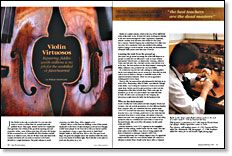Violin Virtuosos
Repairing fiddles worth millions is no job for the unskilled or faint-hearted
Synopsis: William Duckworth of Fine Woodworking spent time with master restorer John Becker, who with his employees repairs rare and valuable violins, and with Horacio Pinerio, who makes and restores violins and cellos. Duckworth explains how they learned their art, and who the dead masters are. Finishes are a secret, as are the values of some of the instruments they work on. The original instrument makers anticipated that wood movement would lead to repair issues, so they glued the violins with hide glue, which is easily loosened, with the right touch.
John Becker is the only woodworker I’ve ever met who comes to work in a white shirt, tie, pressed pants and polished shoes. Then again, Becker and his two employees don’t generate a lot of dust as they go about repairing rare and expensive violins, some of them more than 300 years old. Except for the occasional use of a beautiful old Oliver bandsaw tucked away in an adjacent room, they do all their work with hand tools. A major restoration job can mean as much as 2,000 hours devoted to a single instrument. The goal is always to avoid removing very little, if any, of the original wood.
Becker’s shop is in the Fine Arts Building, a turn-of-the-century landmark on the shore of Lake Michigan in downtown Chicago. A little brass plaque by the front door tells you that he and his two employees occupy a space that served as Frank Lloyd Wright’s studio in 1908 and from 1910 to 1911 The space is not large, but generous skylights above the windows bathe the room in an even stream of northern light. This looks like a nice place to work.
Becker is a master restorer, which is the top of four skill levels in the violin trade. In the 18 years he’s been working at it (Becker is 38), he’s moved through the ranks—apprentice, repairman, restorer. Keisuke Hori has been with Becker for five years; he’s a restorer. Takeshi Nogawa has worked there for a little over one year; he’s a repairman. Both men studied violin making before coming to work for Becker. In this field, the demonstration of learned skills means more than time of service.
Learning the trade from the ground up
How does one go about becoming one of the half-dozen or so people on earth who are allowed to work on some of these instruments? Schools exist—in Mittenwald, Germany, others in Tokyo and Salt Lake City—but that’s not the route Becker took. As he says, “the best teachers are the dead masters,” meaning the Italian craftsmen who produced the very best fiddles.
He worked his way into the craft, starting by making guitars, but he soon realized there was no money in it. After that, he took a job at Lyon & Healy in Chicago, a venerable name in the musical instrument business, where he was an apprentice making grand-concert harps.
Then in 1981, he answered an advertisement he had seen in an issue of Fine Woodworking. Bein & Fushi, a prominent Chicago violin dealer, was looking for someone to work in its in-house repair shop. Becker moved in and moved up to take over the management of the Bein & Fushi shop. Three years ago, he decided to go on his own and worked out a deal with Bein & Fushi. He still works exclusively for the company, but the business is his.
From Fine Woodworking #122
For the full article, download the PDF below:
Fine Woodworking Recommended Products

Suizan Japanese Pull Saw























Log in or create an account to post a comment.
Sign up Log in